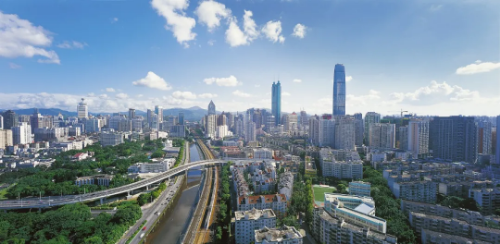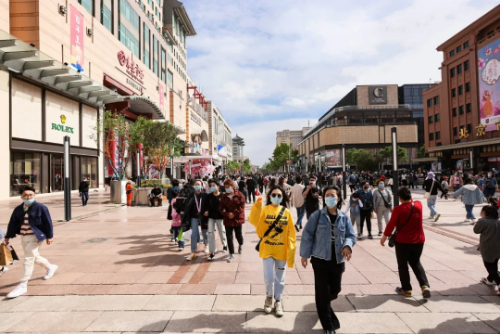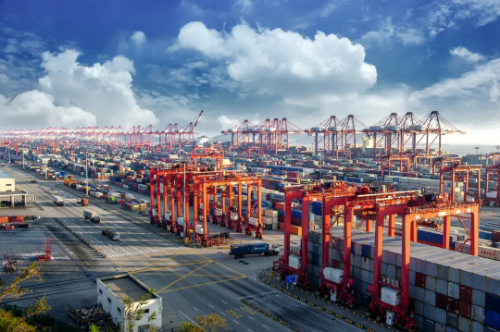Official figures revealed on July 15 show that China's gross domestic product(GDP)expanded 12.7 percent year on year in the first half of 2021 to 53.22 trillion yuan(8.2 trillion U.S. dollars), 5.6 percentage points lower than the level recorded in the first quarter. On a two-year average basis,China's GDP grew 5.3 percent,0.3 percentage points higher than that in the first quarter.
Offering detailed analysis of the country's mid-year performance, Liu Qiao, Dean of Peking University's Guanghua School of Management, pinpoints the traits of China's economic recovery and structural issues worthy of attention while forecasting the country's macro policies in the later half.

TRIO OF GROWTH-DRIVING FORCES
China's overall sound post-Covid-19 economic recovery has shown the tenacity and vigor of its economy, with investment, export and consumption as the three primary forces driving growth. According to Liu,while each of them started to take effect at different time, they ultimately joined forces to consolidate the foundation for the country's recovery.
Export runs the fastest. China's foreign trade rose 27.1 percent year on year to 18.07 trillion yuan in the first half,among which import took up 9.8 trillion yuan,a year-on-year increase of 28.1 percent. Foreign trade have registered fast growth and been playing a key role since the country's economy began recovery last year.
Several structural factors have contributed to this outcome. On the one hand, China handled domestic Covid-19 outbreaks well and resumed work and production relatively early,exporting a huge amount of anti-pandemic products to countries in need; on the other, many countries have not fully recovered from the pandemic and saw a huge gap between supply and demand, which China's import managed to bridge to some extent. As vaccination gains momentum across the world, key Western economies, including emerging markets,will recover, and China’s import orders will diminish. As a result, the outlook for China's import in the later half of 2021 might not be as rosy as that in the first half or late last year. However, with its unique position and influence in the global industrial supply chains, the country's import will remain generally healthy.
In comparison,consumption and investment,especially fixed-asset investment,will see their recoveries somewhat lagging behind. Still,data in the first quarter showed positive growth in both fields,and the recovery sustained in the first half. Figures from the National Bureau of Statistics show that the country's fixed-asset investment went up 12.6 percent year on year in the first half, and it grew 0.35 percent month on month in June. On a two-year average basis, the country's fixed-asset investment grew 4.4 percent, up 1.5 percentage points from the first quarter. However, such a rate is still lower than the year-on-year 5.8 percent in 2019.
According to Liu, these figures are in line with the characters of a Chinese economy that has entered a new phase: the engines of growth are changing. Take manufacturing. Its ratio in China’s GDP has been declining in recent years,which means that it is perfectly normal when investment in manufacturing rebounds to positive levels but its overall growth rate is still lower than previous levels. New growth engines will emerge in the long run,including the industrial introduction and implementation of 5G and 6G technologies in the digital transformation process. Coupled with efforts to achieve carbon neutrality,many new investment options will emerge. Prospect for China's manufacturing investment will still be rosy in the long run.
Compared with import and investment, consumption is a"slow variable" in economic activities. However, data suggest that consumption began to attain positive growth from the first quarter. In the first half, retail sales went up 23 percent year on year to 21.19 trillion yuan. On a two-year average basis, it grew 4.4 percent, 0.2 percentage points higher than that in the first quarter. Still, the two-year average growth is far lower than the year-on-year 8.4 percent in 2019.
Liu attributes this to the fact that the global economy is still plagued by the pandemic. Meanwhile, as forces driving China's economy are experiencing a reshuffle, he called for efforts to strengthen the basic role of consumption in enhancing economy, improving both urban and rural residents' incomes as well as boosting their purchase intentions and expectations for the future.
Liu expects that consumption and investment, in general, will embrace normal cycles of growth this year while export might slow down year on year in the later half.

TREAT IMPORTED INFLATION CALMLY
The recent soaring of commodity prices across the globe have triggered worries about imported inflation.
According to Liu,two factors lead to the rising prices. First,many countries have carried out quantitative easing policies amid the pandemic,greatly boosting liquidity across the world. While supply remains at the same level,the overabundance of money leads to heightened prices.
Second,there has been some contradictions in terms of global supplies. The supply-demand gap still exists as countries where many commodities are made suffer exterior difficulties such as drought and virus infection outbreaks, which boost prices considerably. As China is the main destination of some of these commodities,many worry that the impact of imported inflation might be transmitted to the country's economic system and affecting domestic products. While policymakers have been keeping a close eye on this issue,chances are the global economy will return to normal and the supply-demand gap will not always be this acute. "I'd rather believe that the current price soaring is only temporary,although the ensuing impact of imported inflation has indeed been felt by the Chinese economy," Liu said.
Figures from the National Bureau of Statistics show that consumer prices increased moderately while producer prices remained at a high level. China's consumer price index(CPI)went up by 0.5 percent year on year in the first half,maintaining the same level year on year of the first quarter. The producer price index(PPI)grew 5.1 percent year on year,3.0 percentage points higher from the first quarter levels.
According to Liu, the increase of PPI far exceeds that of CPI, resulting in the price scissors.For companies,the costs of the means and factors of production soar,the effect of which can not be offset by price changes. It shows that our price transmission mechanism that encompasses costs and the prices of the final products is not very smooth.The pressure from soaring costs means that companies have to endure smaller profits,and this is not good news for the long-term development of businesses,especially when many of them are already facing a tough task to reduce debt burdens. Liu calls for more policy support to relieve firms' burdens,reduce their financing costs and help them return to normal operations with the help of tax-related measures.

STRUCTURAL ISSUES WORTHY OF ATTENTION
Liu suggests viewing China's economy through two lenses: one is its overall performance,the other the structural performance.In terms of overall performance,the country's economy is very sound,but there are structural issues that demand attention. For instance,the recovery of consumption is less notable,leading to questions such as how to make consumption one of the key forces driving the country's economy. Meanwhile,at the corporate level,how to help businesses resume normal operations is also a structural question that needs pondering.
One of the major concerns is that macro policies might be unlikely to solve these structural issues. When coping with sudden,major interior or exterior shocks,fiscal and monetary policies usually prove very effective,Liu says,citing the highly successful counter-cyclical measures taken in the recent past. However,in order to effectively address structural issues,structural reforms are required.
Future policies should focus on two aspects:one is how to essentially boost urban and rural residents' disposable incomes so as to unleash the crucial impact of consumption on boosting economy;the other is how to make sure that the vast number of medium,small and micro-sized enterprises,especially those privately-owned businesses,could generate adequate profits and maintain steady,sustainable development amid the uncertainty of interior and exterior environments.
The long-term steady and healthy development of a country's economy depends on a healthy micro foundation. According to China's State Administration for Market Regulation,the country boasts 144 million market entities,which together form the micro foundation for the normal running of the Chinese economy. All industries and firms are connected along the chains. If macro policy can help erase obstacles in major nodes,huge multiplier effect will be unleashed. Policymakers should prioritize helping the numerous medium and smaller-sized enterprises and privately-owned businesses,which have employed a huge proportion of the country's workforce,to feel a stronger sense of gain and find their own path to grow as the country's economy experiences a shift in growth engines.
So how should the country's policy go in the later half of 2021?Liu suggests continuing the combo of neutral monetary policy and relatively active fiscal policy;also,changes in the global environment and other countries' policies should be considered when making policies.Quantitative easing in the U.S. might have reached a turning point and switched to tighter measures in the later half. In this scenario,there are no better responses for China except maintaining the vigor of its economy and consolidating the foundation for its post-Covid-19 recovery.
According to Liu,China's monetary policy should focus on moderately boosting liquidity in order to provide a more relaxed environment for firms to lower financing costs. In addition,many firms have been enduring higher costs of raw materials,and it is crucial to figure out a way to lend concrete support to small and medium-sized firms from the angle of industrial supply chains. It is good news that many new measures are already in place and will see more notable effect in the future so as to boost the vigor of China's economy in the long run.
 Programs
Programs